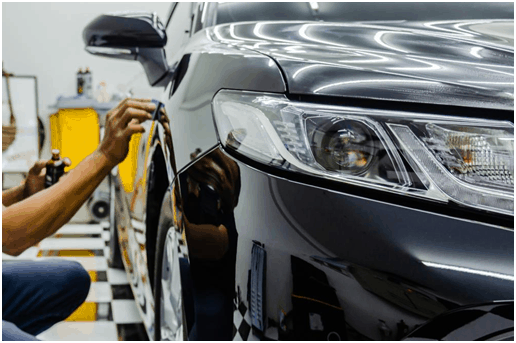How Long Does a Ceramic Coating Last on a Car?
Maintaining the pristine appearance of a new car can be a challenge due to the various elements the vehicle’s paint is exposed to every day. This paint can oxidize from excessive sun exposure, or be damaged by contaminants in the environment. Many car owners apply a ceramic coating to their car bodies to protect the paint from these elements and keep their cars looking new and shiny.
What is car ceramic?
The ceramic coating used to protect the exterior paint on car bodies is usually composed of silica and titanium dioxide. The combination of these two compounds creates a substance that is hydrophobic. When used as a coating this ceramic can repel water from car surfaces and protect the car’s paint from oxidation, corrosion, and UV rays.
Why do people use car ceramic?
Car ceramic provides cars with a layer of protection that keeps the vehicle’s body paint looking vibrant and new for long periods of time. Car wax is also able to provide similar protection to car surfaces, but has to be reapplied every few months in order to maintain the car’s shine. Car ceramic can last for years with a single application, which makes it superior to wax
How does it work?
Car ceramic utilizes nanotechnology to chemically bond with your car’s external surface to provide superior protection from water, soaps, and contaminants in the environment. Car wax on the other hand is a more temporary coating made from carnauba wax and oils. Car wax doesn’t bind to surfaces like ceramic does, which makes it far less durable than ceramic.
Both car ceramic and wax are essentially used as sacrificial protective coatings, but ceramic is used for more heavy duty protection due to the superior, long-lasting protection it provides.
Once ceramic is applied to a car, it won’t need to be waxed. It also makes cleaning the vehicle’s surfaces as easy as washing the windows or windshield. It also forgoes the need for abrasive washes with harsh soaps, even though the ceramic holds up well to multiple cleanings.
The hydrophobic properties of car ceramic discourages water from pooling on your car’s hood, and forces any water droplets that may have landed on your car’s surfaces to bead together and slide off.
Car ceramic can also be applied to car surfaces other than the external body. It be uis sometimes used to protect the interior surfaces of the car from spills and stains
How long do ceramic coatings last?
Ceramic coatings are known for their long lasting protection. However, the duration of protection provided by ceramic coatings can vary based on the type of ceramic used.
Cheaper ceramics that are often applied by car owners themselves tend to last around a year, while the higher end ceramics applied by professional detailers can last for up for 7 years. Some car ceramic manufacturers include a lifetime warranty with their products, so it’s possible for some ceramics to last even longer than 7 years.
Car ceramic tends to last longer when the vehicle is used infrequently and is covered with a car shower-cap when not in use. Vehicles that are regularly parked outside during the daytime may need to have a new layer of ceramic applied twice a year. This is still preferable to wax, which has to be redone every few weeks.
Car ceramics do have their limitations, though. These coatings can protect cars from minor scratches, but many deeper scratches from day-to-day vehicle usage may still show up on the car’s ceramic coated surfaces.
Let’s take a look at different car ceramics available on the market and see how long each one is rated to last.
Car ceramic types and how long they last.
A wide variety of car ceramics are available for vehicle owners looking to add an extra layer of protection to their vehicles. These modern car ceramics can be silica-based, polymer based, or a hybrid of the two.
Car ceramics that contain a high percentage of silica tend to last longer than polymer based coatings. However, these silica based ceramics are more difficult to apply, and usually require the help of a trained and certified professional.
Car ceramic products generally vary on the basis of their protection length as well as the hardness of the coating they provide once the coating has been cured. The following car ceramic products are available on the market and are very popular.
- AvalonKing Armor Shield IX: This ceramic coating is rated to last between 3 and 5 years, and is aimed at cars that are used regularly.
- Color N Drive Ceramic Coating: This product provides cars with a flawless coating that can help maintain the paintwork of vehicles for up to 5 years. This coating can also survive up to 150 washes.
- Migliore Strata: This ceramic coating provides cars with a glossy finish. It usually lasts between 1 and 3 years.
- Ethos Ceramic Coating: This product contains automotive sealant infused with ceramic coating. When applied, it provides vehicles with a slick and glossy finish that looks mirror-like. However, this coating lasts only 12 months before eroding away.
- Micro Detailer Coating: This coating creates a nanoparticle matrix that protects your vehicle from scratches, water corrosion, and oxidation. The hydrophobic properties of this coating make it a breeze to clean. This coating is incredibly durable and lasts up to 7 years.
How do professionals apply ceramic coatings?
Heavy duty car ceramics should be applied only by certified and trained professionals in a sealed, contaminant-free environment. Vehicles may need to be treated before application of the ceramic coating to ensure that the bonding process proceeds smoothly.
Professionally applied ceramic coatings may last longer than ceramic coatings applied by car owners themselves, so you should consider having your ceramic coating applied by a trained and certified car detailer.
The process of applying a ceramic coating can take anywhere from 1 to 5 days depending on the size of the vehicle and the condition of the paint.
The application process usually follows these preparation steps:
- Pre-wash: The vehicle should be hosed down to loosen dirt, debris, and contaminants from its surfaces.
- Wash the car: The car should be washed with water mixed with car shampoo using a wash-mitt or sponge.
- Rinse: Hose down the vehicle after the scrubbing is complete.
- Prepare clay bar lube: Combine a small amount of car shampoo with water in a container.
- Use a clay bar: Dip a clay bar in the lube mixture and glide it back and forth on the surface of your vehicle in straight motions.
- Rinse and dry: Hose down your vehicle with water to rinse off any lube and dry it using a microfiber towel. Use side to side motions instead of circular motions to avoid swirl marks. This can help prevent streak marks on the surface.
- Polish by hand: Polish the surface of your vehicle using a polishing pad and a thin layer of non-waxing polishing compound. A polishing machine could also be used during this step.
- Spray the prep solution: The ceramic coating manufacturer should have specified the prep solution to use for this step. This is usually an isopropyl solution that contains some amount of water. Use a spray bottle to coat the car with a fine mist of this isopropyl.
- Wipe away the prep solution: The prep solution should be wiped away using dry microfiber towels.
- Avoid sunlight: The vehicle should be kept away from sunlight for at least 3 hours before applying the ceramic coating to ensure its surfaces are cool.
Once the preparation process is complete, the ceramic coating can be applied. The ceramic coating application process typically follows these steps:
- Apply the first layer: The first layer of ceramic coating is applied in two-foot by two-foot sections.
- Apply additional layers: More layers are added as needed. Some customers pay for thicker ceramic coats that feature multiple layers.
- Curing: The ceramic is then heat treated under heat-lamps. The coating surface can reach temperatures up to 150 degrees during this process. Vehicles are usually left under heat lamps overnight to complete the curing process.
- Hardening: The ceramic coating needs time to harden. This process usually takes up to 30 days. The vehicle should not be washed during this period.
How to maintain a ceramic coating and help it last longer.
Professional ceramic coatings can last a long time as long as the car is washed and treated with care. It is recommended that car owners develop a washing regimen for maintaining the ceramic coating.
The washing process should be completed using neutral car shampoo, and the car should be dried using a microfiber cloth. Owners should avoid air-drying their cars as it could leave watermarks.
Vehicles with ceramic coatings should avoid being washed in automatic car washes as they can wear down the ceramic coating and leave swirl marks on it.
Are ceramic coatings right for me?
If you’re interested in providing your car with long-term protection that will last for years, ceramic coatings are certainly the way to go. You can purchase any number of DIY ceramic coating kits if you’re interested in applying the coating yourself.
You could also have the ceramic coating applied at a professional car detailer to ensure that the coating is applied properly and will last for years.




